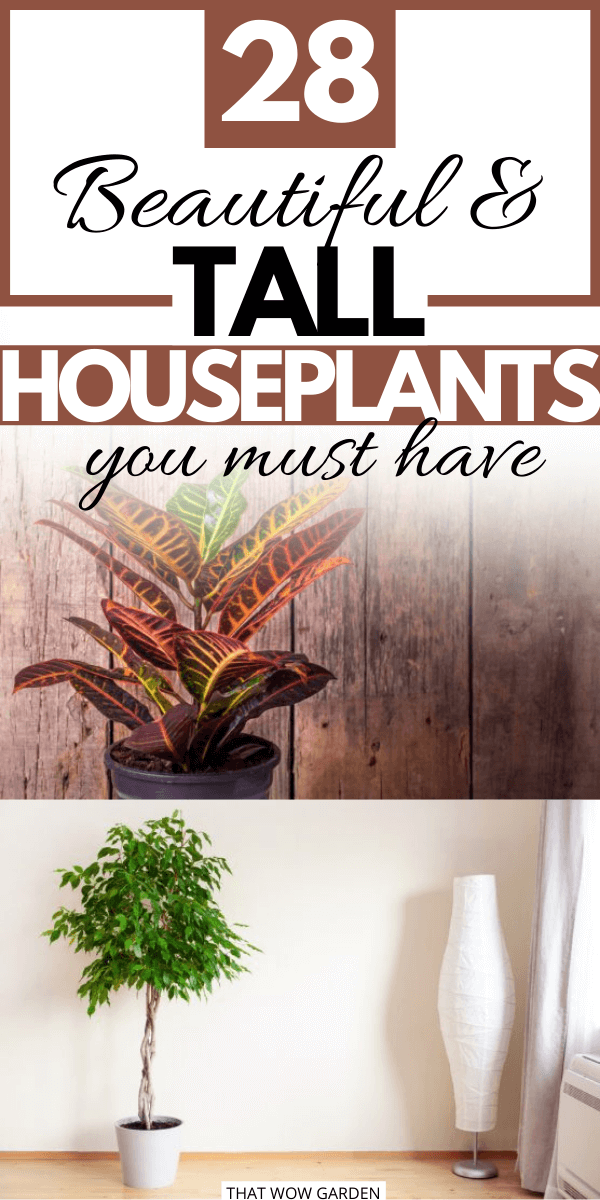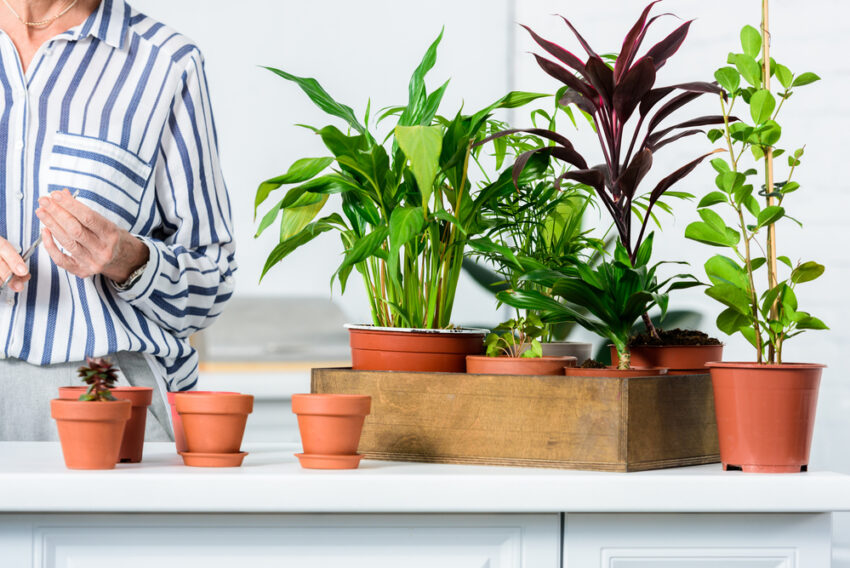Do you want your city apartment to feel like a lush, tropical paradise? There couldn’t be a better option than an indoor green thumb. Say hello to pretty and forgiving houseplants!
Green goods come in so many shapes, colors, and lifestyles and while finding the right ones for your home might seem intriguing at first, they are totally worth it. Since it is not only about welcoming nature into your living room, wouldn’t you go for something that would elevate your space as well? Everyone deserves a tall or large houseplant that can make your cozy room look twice as big.
To help find your tall plant match, we have dug up some well-known and not-so-popular but worthy tall houseplants, or let’s just call them indoor trees. Some of these grand specimens are tall enough to touch the ceiling, some can adapt really quickly in any environment and some are super hardy and they can even survive in the darkest corner of a room.
Check out 28 tall and large houseplants and maximize your interiors with these green wonders!
28 Best Tall Indoor Plants
1. Norfolk Island Pine
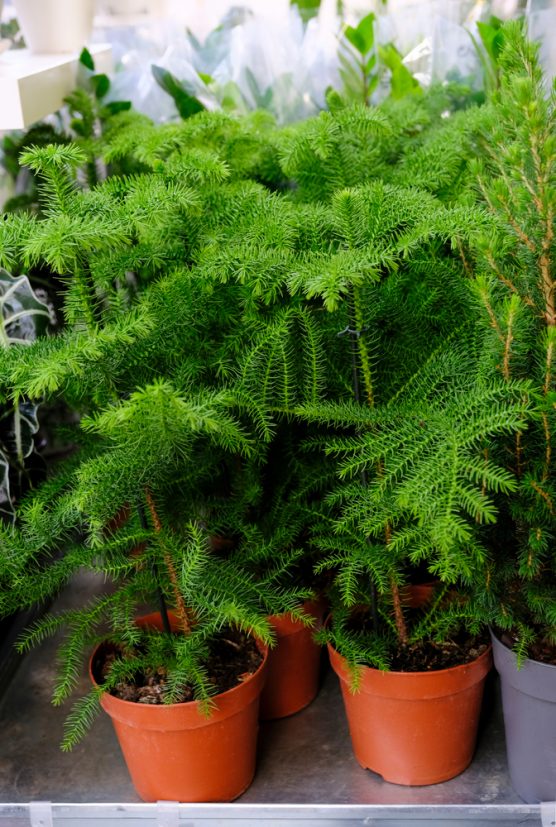
Araucaria heterophylla, commonly known as Norfolk island pine, is used as a cute, little Christmas tree houseplant and it is extremely popular in holidays. They are quite big for a houseplant and the pine leaves would look like a seasonal plant once the Christmas holidays are over. Norfolk pines make wonderful houseplants and you cannot abandon this harry pine tree.
Caring for Norfold Island Pine:
Though they aren’t as hardy as true pines, their characteristics are more like gardenia or orchids and they do need care to thrive. Belonging to the tropical origin, Norfolk island pines cannot tolerate temperatures below 1 C and they need high humidity to survive. You can install a humidifier, use a pebble tray with water, or mist it weekly to maintain the humidity.
Norfolk pine trees love south-facing windows and several hours of direct or indirect bright light would make it smile. Water the plant only when the topmost soil feels dry and fertilizes it in spring and summer to keep a check on its health.
2. Guiana Chestnut
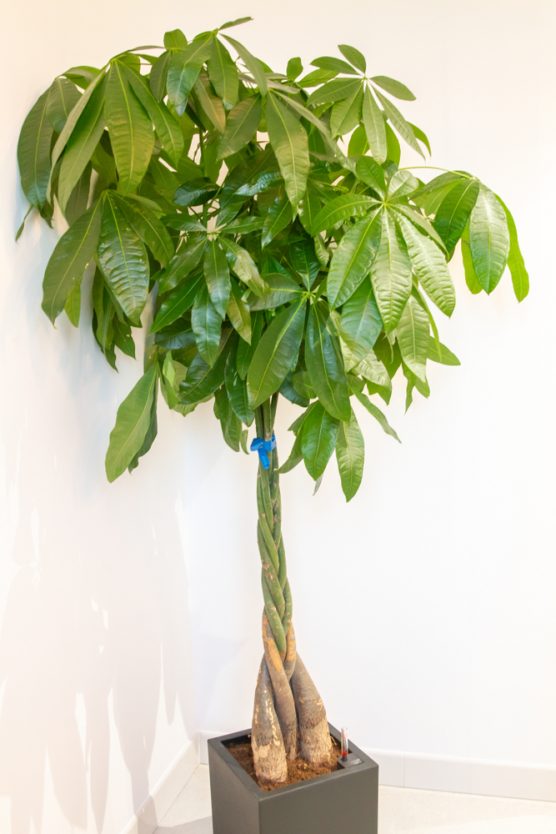
Pachira aquatica or Guiana chestnut is an attractive and hardy species, popularized as a houseplant in Taiwan back in the 1980s. They have unique, braided trunks that look amazing and would be a good choice for artificially lit areas.
Also known as the money tree, this species is prominent among people who practice Feng Shui to create positive energy in their house. They have slim green stems that are topped with palmate leaves and bears oval green pod-like fruits. They can also bear flowers, but this species is pollinated by bats!
Caring for Guiana Chestnut:
Money trees need medium to bright light and they do well in fluorescent light as well. Well-draining, fertile potting soil, and watering only when the topsoil is dry would keep them super happy. Don’t overwater it, keep it in moderate temperatures and maintain high humidity indoors and the money tree will never frown.
3. Ficus Benjamina
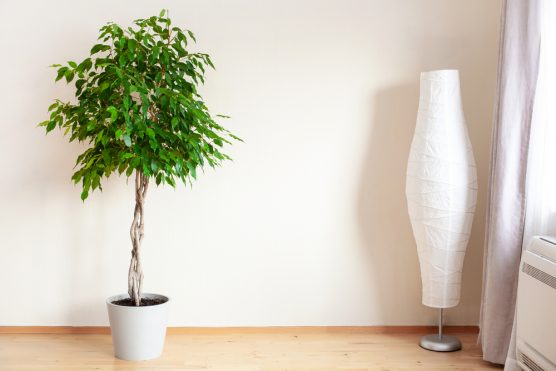
A typical tree with a spreading canopy, Ficus Benjamina, or simply ficus trees are very popular houseplants. They have a single trunk with dark green or variegated big leaves. The trunks are pliable and some gardeners even braid or twist them to make it look extra appealing.
Caring for Ficus Benjamina:
Growing ficus indoors would need relatively high humidity and you must mist the plant regularly. They hate overly wet roots, and you must check the soil before watering.
Ficus plants are rapid growers and they need plenty of nutrients to grow well. You have to fertilize it once every month during spring and summer and reduce it during dormancy.
Also known as rubber trees or fig fruit trees, ficus trees enjoy bright, indirect light and room temperatures. The trees are prone to pest invasions and you can treat them with neem oil. They are also very quick to give signs of distress, watch out for them!
4. Dragon Tree
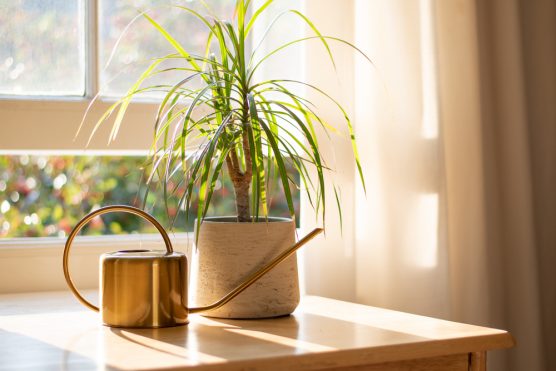
A popular container plant, the Madagascar dragon tree is a tree in every sense. Dracaena marginata has very long, variegated leaves that have red on both sides and a greenish center. The extra-long leaves ensure its name in the list of large indoor plants and it is often planted in tropical gardens as well.
Dracaena has about 120 different species, almost all hardy plants that are summer lovers and would need a place indoors in winters. A dragon tree can be about 15 feet tall when fully grown, though this is unlikely in a pot.
Caring for Dragon Tree:
A Madagascar dragon tree has a strong root system that ensures it remains tough through thicks and thins. Keep it in bright, indirect light and water it frequently with non-fluoridated water. They love to stay at room temperatures, it can tolerate lower temperatures, but that would affect its growth rate.
5. Parlor Palm
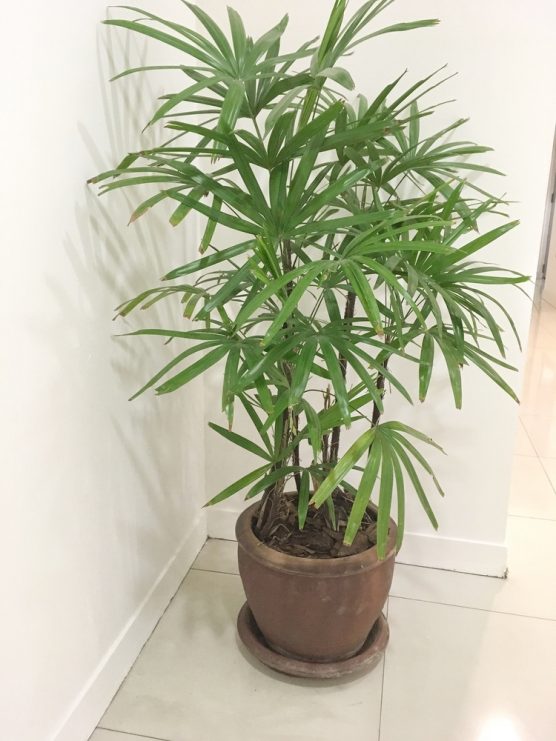
Are you looking for a low-maintenance yet tall and attractive houseplant? Chamaedorea Elegans or parlor palm has made a strong statement for over 150 years now and they don’t demand much. They are easily available, cheap, and do fine in certain conditions that might upset other indoor plants.
The super long, linear leaflets growing on single stems that sprout from a central clump distinguish it from similar species. Those delicate leaves often get attacked by spider mites and you must try to keep them at bay.
Caring for Parlor Palm:
Since it is prone to root rot, you can keep it too dry but never too wet. Maintain an ideal level of moisture and keep it away from direct sunlight.
Parlor palm care list doesn’t involve a misting gun, so you don’t have to worry about the humidity. This plant can tolerate quite a lot of neglect, but with little care, you can keep the leaves unblemished for several growing seasons!
6. European Olive

Growing olive trees indoors is becoming increasingly popular these days, and you wanted a tall houseplant, right? Olive trees are not too demanding and you can bring that warm, sunny Mediterranean vibe right into your living room!
Olive trees have shiny silver leaves and would look amazing amidst your indoor green thumb. The olive fruit is edible and it can be pressed for oil which has healing properties. Beware, there are several varieties of olive and you must bring home European olive as they make one of the best houseplants.
Caring for European Olive:
The optimum conditions for this tree to survive would be high heat and plenty of sunshine. Use well-drained soil in a container or planter and provide drip irrigation during the first four years.
Although it flourishes in hot, dry areas, you can keep it thriving indoors with some minor arrangements. After all, nothing is impossible and you can do this.
7. Desert Rose
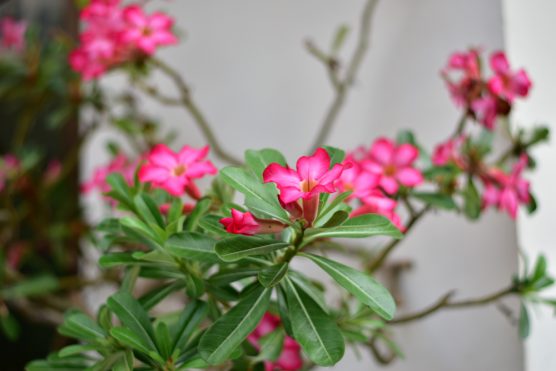
Don’t get surprised, we are not only exploring tall houseplants but large indoor plants as well and desert rose surely belongs to this list. Adenium desert roses are perfect for the novice or intrepid gardeners and they are also a good choice for container gardens or indoor green thumb.
Caring for Desert Rose:
One of the popular ornamental plants in the US, caring for a desert rose would be easier if you gather some knowledge about the life cycle of the species. They grow full crowns of brightly colored tubular flowers supported by a swollen trunk that stores ample moisture. This is a tropical succulent and if you notice a skinny stem, it might be moisture deficient.
Choose a sunny window for this rose, but protect it from noonday sun as it might scorch the foliage. Keep the soil moist in spring and summer and reduce watering when the plant is dormant.
8. Corn Plant
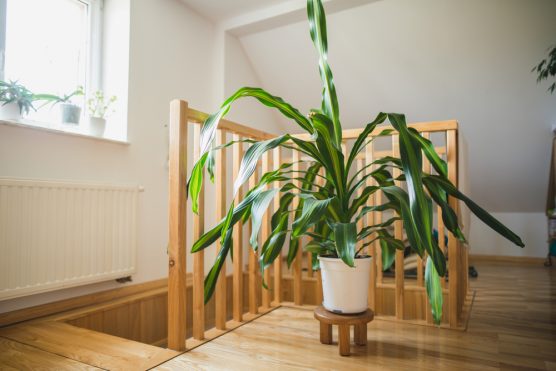
With a delightful, palm-like silhouette, the corn plant is a sister species of the Madagascar dragon tree and it belongs to the Dracaena family. Dracaena fragrans, also known as a mass cane or corn plant, is an amazing plant for beginners just like dragon trees. They have lance-shaped leaves, yellow borders, and a glossy green center, mostly variegated.
It is a tropical native, hence won’t survive in frosty weather. The corn plant is a worthy houseplant as it aids in the removal of indoor pollutants like toluene, xylene, and formaldehyde.
Caring for Corn:
Dracaena corn plant prefers room temperature, needs light shade or filtered sunlight and the potting soil must be evenly moist. Try to use non-fluoridated water and don’t expose it to chemicals. These minute tricks can keep it happy for years and you will never regret bringing it home!
9. Umbrella Tree
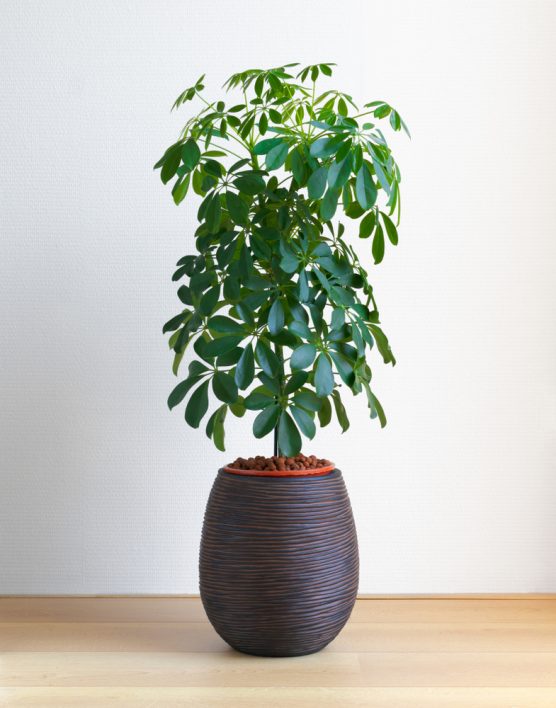
The Schefflera houseplant, also known as an umbrella tree or dwarf umbrella, is extremely popular in households. The plant care is easy and you don’t have to work much to keep it healthy and lush. They have big, deep-green leaves with a hinge of yellow in the centers and look like citrus plants.
Caring for Umbrella Tree:
To keep Schefflera growing and healthy, keep it in bright, indirect light. The plant can get leggy and floppy if they receive too little light and direct light can burn the leaves. Water it only when the soil pot dries out and never overwater it, that could be fatal!
This tall and hardy houseplant is good looking and doesn’t have much demand. Prune it occasionally and fertilize it once a year, if you want to. You will see it happy and smiling!
10. Candelabra Cactus
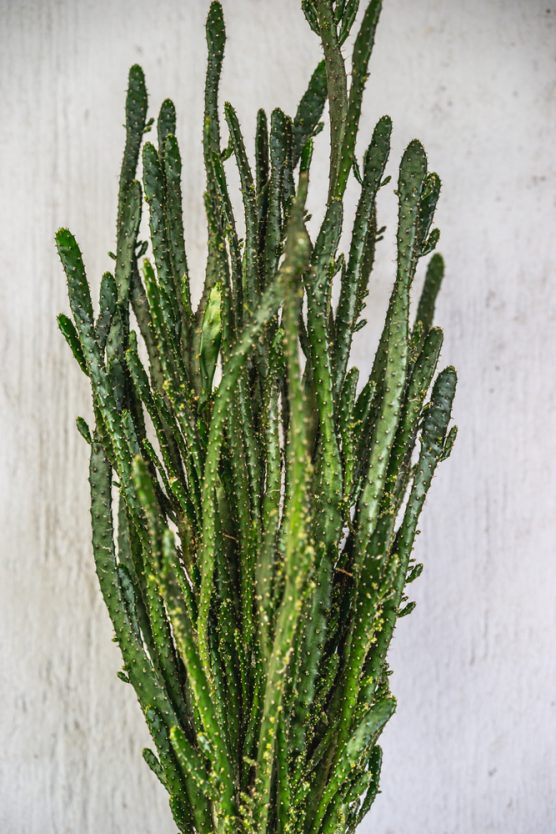
Belonging to the family of Euphorbia, the candelabra cactus is not an actual cactus, it is a succulent. This plant has several other names like dragon bone cactus, false cactus, and mottled spurge. In northern zones, you would need a greenhouse to grow them or maybe in a sunny room.
They have triangular branches with small, green heart-shaped leaves and reddish-pink spines. The stems of candelabra cactus have milky, latex sap that could be toxic and must be handled with care.
Caring for Candelabra Cactus:
Choose a well-draining pot for this tall houseplant and water it once per week in the growing season. With some protection from the midday light, these low maintenance plants need full sun to thrive.. You can also prune it back in shape and keep it tidy.
11. Natal Mahogany
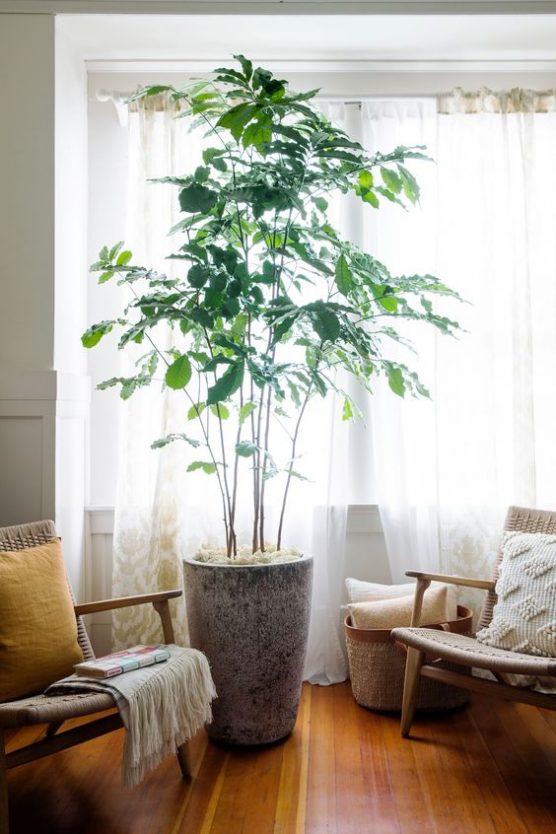
The forest Natal Mahogany or Trichilia dracaena can be a good choice if you are looking for tall houseplants. Just like dragon trees, they can tolerate low light and adjust well to fluorescent light. Natal Mahogany is an exotic looking houseplant that has dark, green shiny leaves and comes with a bushy appearance.
Caring for Natal Mahogany:
A tall houseplant that loves to be watered, Natal Mahogany needs the soil to be evenly moist all the time. They are very forgiving in case of overwatering but don’t go overboard with that. Check for signs of underwatering and overwatering and act accordingly.
They thrive in medium to low light and make sure you rotate them periodically and photosynthesize all the sides. Fertilize once a month with organic fertilizer and you are good to go.
12. Fiddle Leaf Fig
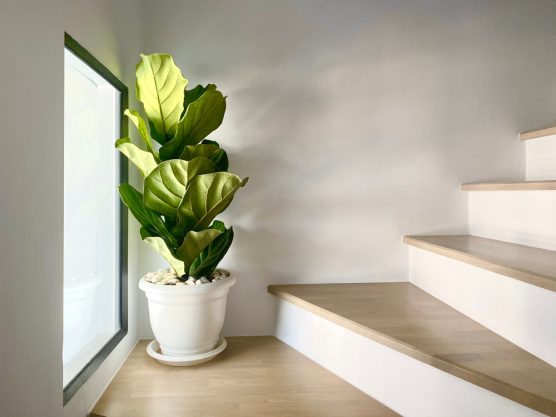
With leaves in the size and shape of a fiddle, Ficus lyrata or fiddle leaf fig tree is a stunning houseplant with unmatched visual impact. Those huge, wavy green leaves can grow more than a foot long and the tree can even touch the ceiling. Their lush and sculptural shape can easily bring home that jungle-like vibe!
Caring for Fiddle Leaf Fig:
The fiddle leaf fig prefers a warm and humid environment and a sunny window would be an ideal location. The soil must be kept evenly moist and periodic waterings are also needed. This plant is very sensitive to environmental changes and as a shock response, they drop leaves.
Maintain moderate humidity to keep the fiddle leaves looking extra appealing and dust the leaves often. Fertilize it during the growing season and watch out for signs of overwatering, which is a common mistake. Brown spots and leaves dropping are some common signs to watch out for.
13. Pachycereus pringlei
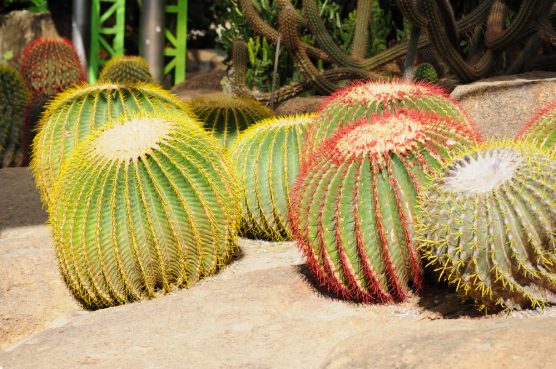
A large and easy cactus, Pachycereus pringlei is one of those species that share a scientific and common name. It is a perennial that grows well indoors and with proper care, it can get really tall!
Caring for Pachycereus Pringlei:
Use light, porous, and well-drained soil to plant this unique cactus species. They have low water requirements and hence infrequent watering would do good. The amount depends on the season as your cactus can sometimes evaporate more than receive.
Take it outside during the summer days and keep it in a cool room in winter. They can thrive on medium light, bright light would be the best. If you want beautiful, vigorous plants, supply it with fertilizers and watch the cactus flourishing!
14. Cascade Palm
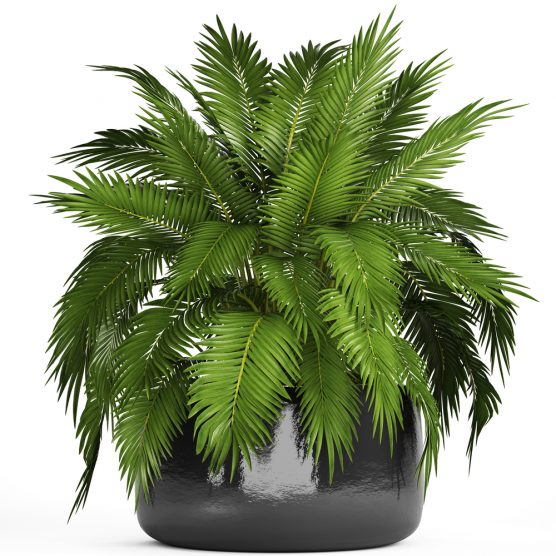
Want to bring in a tropical vibe right into your living room? Cascade palm is here, waiting for its welcome! Chamaedorea cataractarum or cat palms have glossy, dark green leaves on thin shoots. They have cascading sets of fronds and trunkless visage combined with dense foliage which looks very appealing.
Caring for Cascade Palm:
A little high-maintenance due to its tropical origin, cascade palms adapt well in containers when supported by good weather conditions. They can get up to 3 feet tall if kept indoors, you wanted a tall houseplant, right?
Grow it in well-drained, organic mix soil which is consistently moist. Indoor cascade palms do well in low or filtered light and placing them on or near a window sill would just work fine. Keep it smiling by watering it twice a week and fertilizing it about three times a month.
15. ZZ Plant
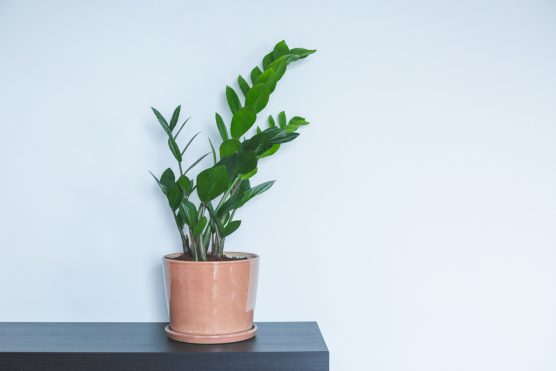
Not for the green thumb, but surely for the brown thumb, the virtually indestructible ZZ plant would be an amazing addition.
Frequently mistaken for fake plants, the ZZ plant can be a good choice if you are looking for large indoor plants, and taking care of this one is super easy. Interestingly, not only nurseries, this hardy, and tall beauty has made its way onto the shelves of hardware stores as well!
Caring for ZZ plant:
ZZ plants can tolerate months and months of neglect and still smile and look amazing. Zamioculcas zamiifolia has got graceful stems with a wand-like, bulbous base paired with fleshy, oval-shaped leaves with a shiny wax coating. I told you, it has got some appealing looks.
ZZ plants love bright to moderate, indirect light and it can thrive in extremely low-levels of light as well. Water this plant only when the soil has dried out, and mind it, overwatering can kill it. No wonder it has been an ideal plant for windowless office or bathroom and even suitable for forgetful gardeners!
16. Birds of Paradise
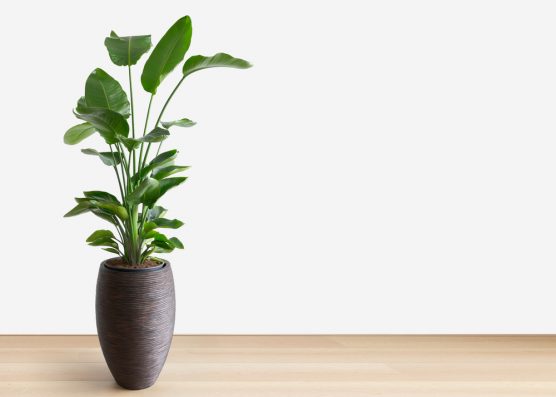
Often confused with banana plants, Strelitzia reginae or birds of paradise is an African native that houses monster plants as well. While houseplants can get up to 8 feet, some species of Strelitzia can grow up to 20 feet tall. They are well-known for their remarkable size and lush and rich foliage.
Caring for Birds Of Paradise:
Birds of paradise need well-draining, rich soil, and thrive in bright, indirect light. Water it once every one or two weeks, allowing the soil to dry out between intervals. If you want blooms, expose it in full sun for a few hours during the blooming season.
When grown in containers, they do need lots of soluble plant food to grow. It is prone to mealybugs and spider mites invasion and a systemic insecticide would treat them. Do not plant this species too deeply in the soil as minimal root exposure promotes blooming!
17. Snake Plant
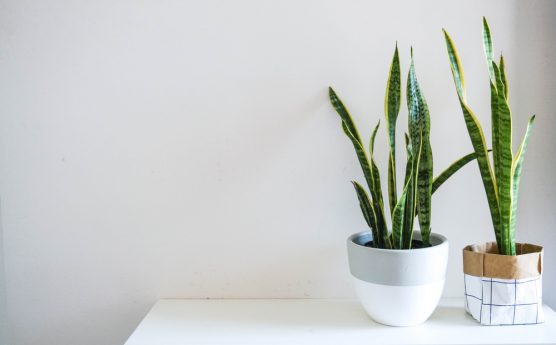
An old-school succulent, popular in home decor due to its long, sinuous foliage is Sansevieria or snake plant. In recent years, succulents have made their way into the hottest trends as they look exotic and mostly easy to grow. From tall and elegant, to short and cylindrical, the snake plant has several varieties and you can choose taller ones.
Snake plants possess variegated leaves that display streaks of gray, yellow, silver, or white, bringing versatility in every sense. The leathery sharply pointed texture together with the streaks gives them the resemblance of exotic snakes. It is tough, forgiving, and often called an indestructible houseplant.
Caring for Snake plant:
Except for direct sunlight, it can thrive in absolutely any light condition and do fine. Use a heavy clay pot and maintain good drainage for the soil.
Since the snake plant is succulent, the leaves are water reservoirs. Water it once or twice a week and dust the leaves occasionally.
18. Karaka Trees
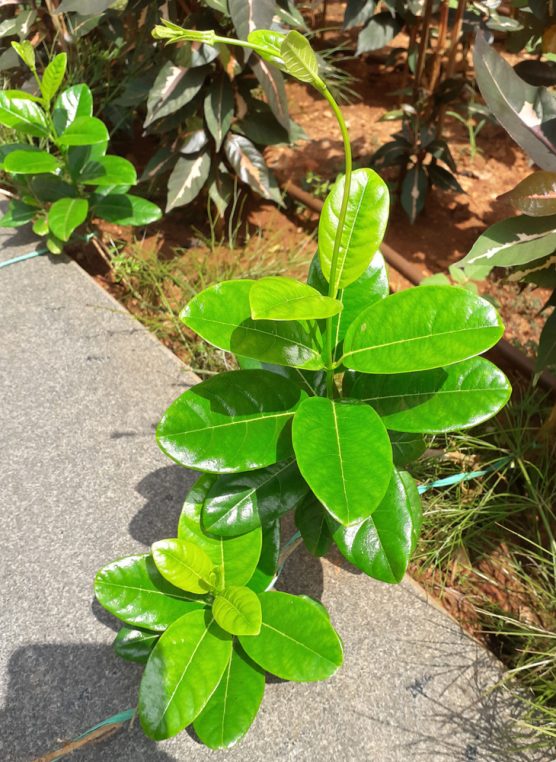
Corynocarpus laevigatus, also known as karaka trees, is often used as tall houseplants for home decor. New Zealand Laurel or karaka tree is long-loved by plantscapers in the US for its incredible foliage and attractive branches.
They have large, elliptic-oblong, glossy leaves that are mostly dark to bright green. Karaka can bear flowers that are small, greenish-yellow, but blooms aren’t common when grown indoors. They bear citrus-like fruits resembling orange drupes, large, slightly asymmetric, and edible.
Caring for Karaka trees:
Karaka trees need moist, but not wet soil to thrive and you must check out the soil before watering. Though it can grow in semi-shade, it is better to place it near a window and feed it bright, indirect light. Fertilize it during warmer months to keep it healthy and happy.
19. Yucca Plant
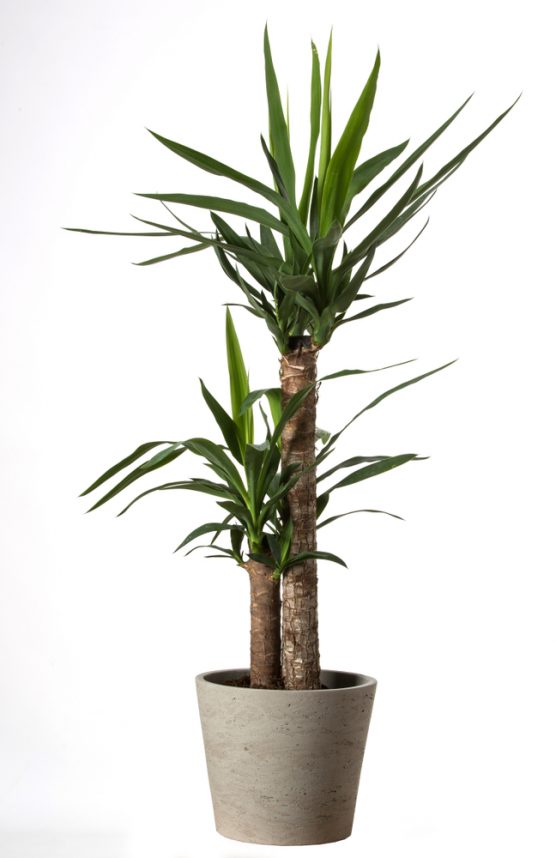
Yucca plant works as part of an attractive display and it adds a focal point to your indoor green thumb. There are more than 20 species of yucca and if you want tall houseplants, go for taller varieties. A typical yucca plant can grow up to 25 feet tall outdoors and if planted indoors, the maximum height is 10 feet.
The leaves range from bluish to greenish variegations with cream, white and yellow. Mostly growing on canes or woody stems, yucca plants have to be located in a partially shaded area indoors. Bright, indirect light ensures the color of the leaves is good.
Caring for Yucca plant:
Yucca plants are somewhat drought-tolerant and light fertilization is required when growing it in containers. Use a heavy soil that could hold the plant upright and soon you would see division from offsets, called pups. Move the plant outdoors if possible during warmer months and it will keep blushing for years!
20. Calamondin Orange Tree

Calamondin orange tree is a cross between a kumquat and mandarin orange and this hybrid species is cold and hardy citrus. First introduced in China, it is widely cultivated throughout southern Asia and the Philippines for their citrus juice. In the US, it is mainly used for ornamental purposes and also as a bonsai specimen.
Calamondin trees are small, bushy with evergreen leaves, and one of the hardiest citrus varieties. They bear tasty orange-scented fruits resembling a tangerine and they persist through winter. You can make a wonderful marmalade with this cross tangerine!
Caring for Calamondin Orange Tree:
Calamondin trees are most productive when grown in full sun, they can also thrive in shade and love warm temperatures. It is drought-tolerant but has to be watered during dry periods. If you want to enjoy those juicy fruits, fertilize once every month during the growing season!
21. Areca Palm
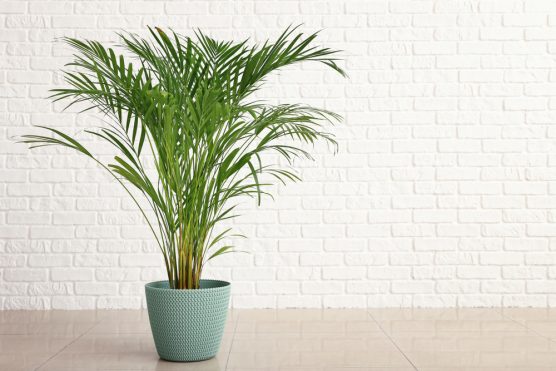
Adding another palm species to the list, Chrysalidocarpus lutescens or areca palm is one of the most popular houseplants used to decorate interiors. Areca palm has arching fonds with up to 100 leaflets each. This big and bold plant has got looks to die for and you can never ignore their presence.
They have a lifespan of 10 years and the good news is, it tolerates trimming without repercussions. You can trim the leaves since they can grow quite big, and keep it for years in your living room.
Caring for Areca palm:
Areca palms need bright, indirect light and they don’t tolerate direct light as they leave turn yellowish-green. The soil must be kept moist during spring and summer and allow the soil to dry in other seasons.
It is one of the sophisticated palm species as areca palm cannot tolerate neglect. Fertilize it evenly during spring and repot it once every three years to avoid crowding of roots. Growing this plant indoors would be worth it when you see those lush, appealing foliage brightening up your home.
22. Monstera
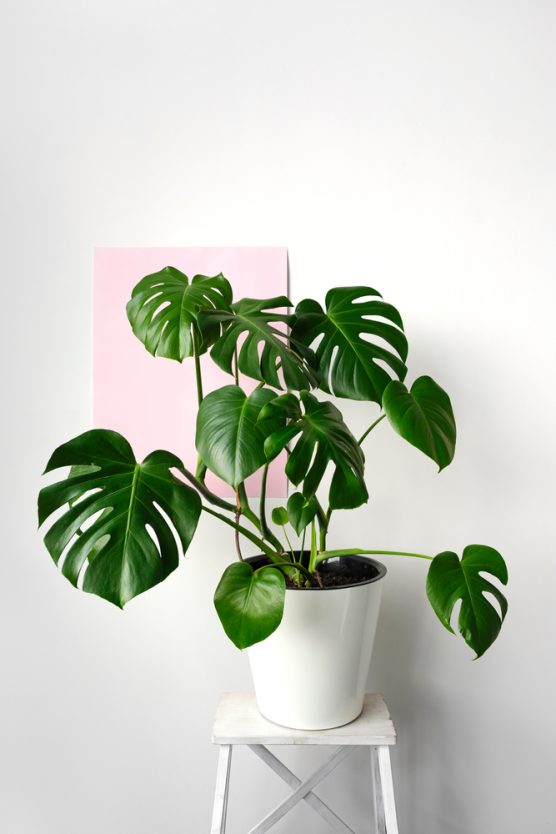
Houseplants do not have the most appealing names, but monstera here has got those statement leaves. You must have spotted the graphic leaves on wallpapers, pillows, and whatnot, they deserve it, right?
Since you are looking for large houseplants, Monstera Deliciosa would be your best pick. They can grow enormous like more than 10 feet tall and up to 2 feet spreading. This variety is also known as Mexican Breadfruit as they bear corn-cob shaped fruits which aren’t delicious, but edible.
Caring for Monstera plant:
Find the balance between shade and sun for growing monstera plants and since it is mostly placed in the living room, the indirect sun would be optimum. Water it evenly once a week and keep the environment moderately humid.
23. Philodendron selloum
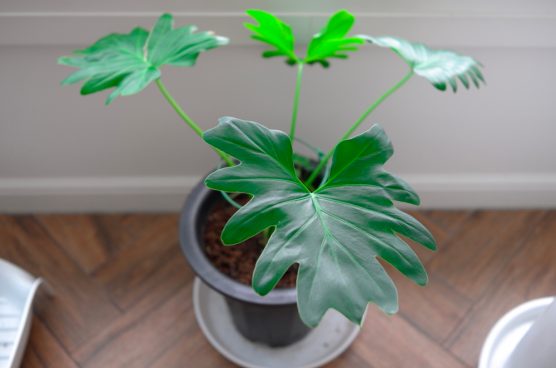
Philodendron selloum or tree philodendron is a tall variety of the philodendron species which is native to South America. If grown indoors, they can spread up to 5 feet and the care and maintenance are fairly easy for this one. Philodendron selloum has dark green, shiny leaves that are deeply lobed with prominent trunks in mature trees.
They come with a wild, tropical look and the dramatic lush foliage looks amazing if placed in a large area. It would be an amazing choice for terrace gardens as this species is resistant to the wind.
Caring for Philodendron selloum:
Bright, indirect light keeps a philodendron selloum happy and it needs a Floridian home i.e. temperatures not more than 30 degree Celcius. Water it once every week and use diluted regular fertilizers once a month. It is always better to keep one person in charge of the care of sensitive houseplants like this one.
24. Ming Aralia
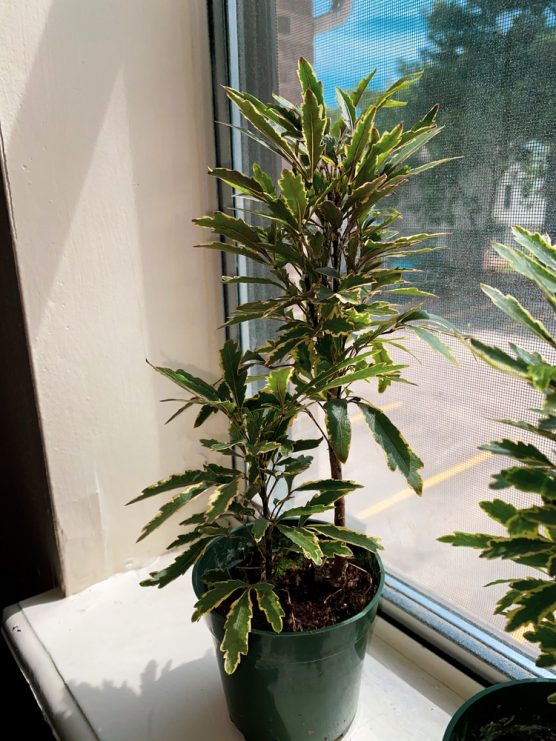
Ming Aralia or Polyscias fruticosa is one of the easiest and loveliest houseplants available and it can bring plenty of greens indoors. It is prone to grow up, but the leaves spread out as well and it can be considered a large houseplant. Ming Aralia makes an appealing outdoor shrub and it can be trained into some amazing showpieces.
Ming Aralia is a tropical species and it brings a certain Asian vibe right into your green thumb. It has light green foliage with white borders and some varieties also possess variegated foliage.
Caring for Ming Aralia:
Like every tropical species, Ming Aralia loves warm environments and thrives best in medium, indirect light. Keep the soil moist always and you can prune it occasionally to maintain the show. With its interesting cuts and crooked stems, this plant will surely make a splash in your house.
25. Croton
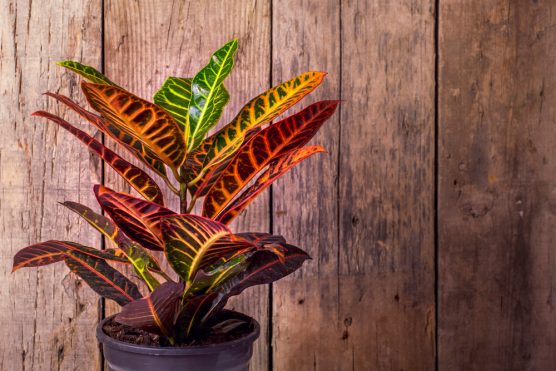
A houseplant that has large leaves clusters that give it volume and can get up to 10 feet tall, croton ticks every box for an enormous houseplant. Codiaeum variegatum or croton plant is a resilient and hard-to-kill plant. There are several varieties of croton and if you dug deep, you might even get a species that matches your decor!
The leaves of croton can be green, red, orange, pink, and so on and all of them have vivid needs. They do have dwarf varieties as well that grow up to 3 feet indoors.
Caring for Croton:
Though the light requirement is different from one variety to the other, all of them thrive on high humidity. It is observed that the more colorful and variegated the croton plant, the more are the light needs.
Croton has a reputation for being fussy because they often suffer from leaf loss when they are moved. By avoiding movement and taking proper care, your croton plant would be super happy.
26. Jade Plant
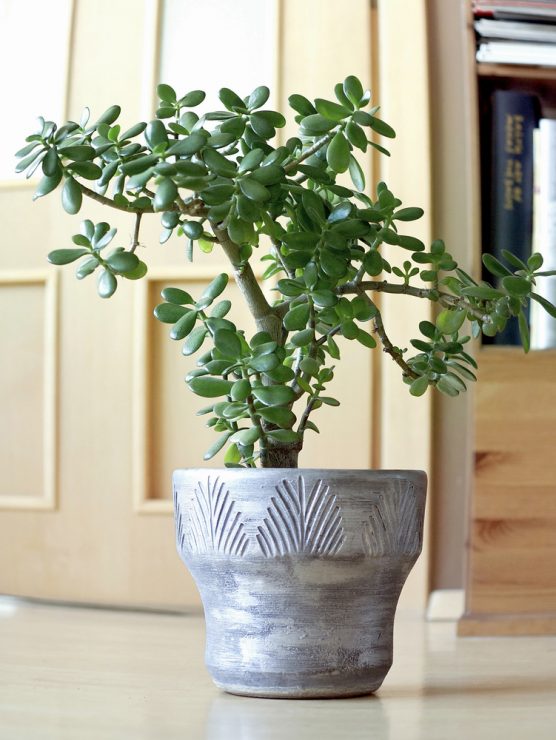
Crassula ovata, commonly known as the jade plant, has been a household name for many years and since succulents are the talk of the town now, the jade plant trending. Jade plants have fleshy leaves and they are very undemanding in nature. We did talk about how money trees bring luck, and jade or money plants are no less!
Jade plants signify luck and prosperity in Asian cultures and it is mostly kept in the front door to welcome money into the home. Sometimes used as a housewarming gift, jade plants do not get much tall, but those fleshy leaves spread out and give volume.
Caring for Jade plant:
For best vigor and foliage color, give it a mix or bright direct and indirect sun. Jade plants succumb to overwatering so let the soil dry out completely before you water it. Though it is a slow grower, jade plants bear clusters of small, star-shaped pale pink or white flowers blooming in early spring. So, it has got glossy and fleshy leaves together with flowers and luck in store for you!
27. Bamboo Palm
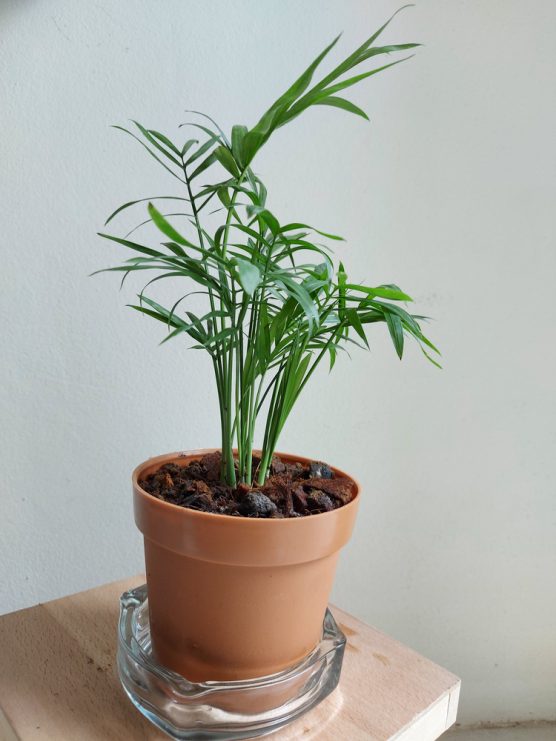
Sister of lucky bamboo, the bamboo palm is a tall species that can grow up to 12 feet tall when fully mature. Unlike other bamboo varieties, Chamaedorea seifrizii or bamboo palm can thrive well in low light conditions, but the height would be shorter with low light.
A healthy bamboo palm has dark green leaves and tends to stand erect. choose a big pot for growing this one and always start with a healthy plant. Since bamboo palms bring warmth and color to any room, it would be an amazing addition to your indoor garden.
Caring for Bamboo palm:
To keep your tall houseplant happy, use filtered water and water it until the soil is evenly moist. Use granular fertilizers during the growing season and re-pot it immediately if it becomes too large for the present container. Bamboo palms would not take much of your time and energy, just some easy care, and it would flourish!
28. Juniper Bonsai Tree
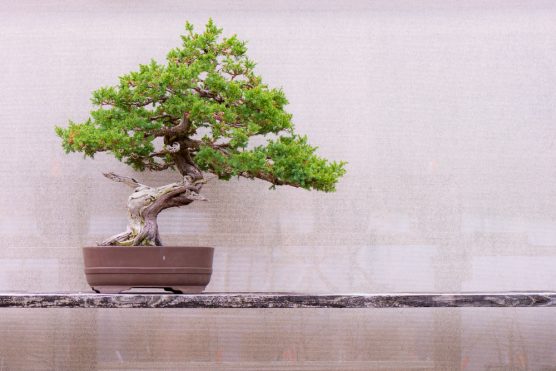
You must have heard about this one and I would guess that the stunning aesthetics of this plant had attracted you. Juniper bonsai trees are miniature trees topped with appealing looks and the color of the foliage makes it aesthetically beautiful. Belonging to the Cypress family, it is coniferous that can grow up to 12 feet indoors.
Popular in numerous countries across the globe, juniper bonsai trees are also put on displays in nursery exhibitions and they never fail to impress. If you just take care of the light and humidity, this tree can thrive in any environment.
Caring for Juniper Bonsai Tree:
Ensure that the plant receives four hours of sunlight every day and keep the soil slightly dry. Don’t keep it dry for a prolonged period and water it when the topmost layer is dry. Mist it regularly to maintain the humidity and fertilize it once a month in spring and fall. Trust me, you would love to see that small tree in your indoor garden!
You wanted tall houseplants and we spoiled you with choices. Once established, these green friends would surely grace your interiors with their beauty. Choose the best from the lot and get to work. Happy planting!

